Identification from diverse mammalian poxviruses of host-range regulatory genes functioning equivalently to vaccinia virus C7L
- PMID: 18054061
- PMCID: PMC2276162
- DOI: 10.1016/j.virol.2007.10.023
Identification from diverse mammalian poxviruses of host-range regulatory genes functioning equivalently to vaccinia virus C7L
Abstract
Vaccinia virus (VACV) C7L is a host-range gene that regulates cellular tropism of VACV. Distantly related C7L homologues are encoded by nearly all mammalian poxviruses, but whether they are host-range genes functioning similar to VACV C7L has not been determined. Here, we used VACV as a model system to analyze five different C7L homologues from diverse mammalian poxviruses for their abilities to regulate poxvirus cellular tropism. Three C7L homologues (myxoma virus M63R, M64R and cowpox virus 020), when expressed with an epitope tag and from a VACV mutant lacking the host-range genes K1L and C7L (vK1L-C7L-), failed to support productive viral replication in human and murine cells. In nonpermissive cells, these viruses did not synthesize viral late proteins, expressed a reduced level of the early protein E3L, and were defective at suppressing cellular PKR activation. In contrast, two other C7L homologues, myxoma virus (MYXV) M62R and yaba-like disease virus (YLDV) 67R, when expressed with an epitope tag and from vK1L(-)C7L(-), supported normal viral replication in human and murine cells and restored the ability of the virus to suppress PKR activation. Furthermore, M62R rescued the defect of vK1L(-)C7L(-) at replicating and disseminating in mice following intranasal inoculation. These results show that MYXV M62R and YLDV 67R function equivalently to C7L at supporting VACV replication in mammalian hosts and suggest that a C7L-like host-range gene is essential for the replication of many mammalian poxviruses in mammalian hosts.
Figures

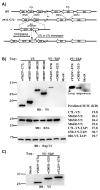
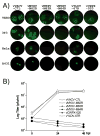
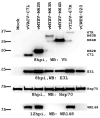
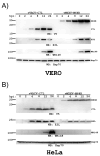
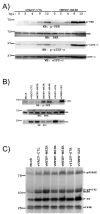
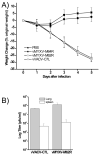
Similar articles
-
C7L family of poxvirus host range genes inhibits antiviral activities induced by type I interferons and interferon regulatory factor 1.J Virol. 2012 Apr;86(8):4538-47. doi: 10.1128/JVI.06140-11. Epub 2012 Feb 15. J Virol. 2012. PMID: 22345458 Free PMC article.
-
Vaccinia virus K1L and C7L inhibit antiviral activities induced by type I interferons.J Virol. 2009 Oct;83(20):10627-36. doi: 10.1128/JVI.01260-09. Epub 2009 Aug 5. J Virol. 2009. PMID: 19656868 Free PMC article.
-
Sequence and phylogenetic analysis of host-range (E3L, K3L, and C7L) and structural protein (B5R) genes of buffalopox virus isolates from buffalo, cattle, and human in India.Virus Genes. 2012 Dec;45(3):488-98. doi: 10.1007/s11262-012-0788-8. Epub 2012 Aug 8. Virus Genes. 2012. PMID: 22872567
-
The poxvirus C7L host range factor superfamily.Curr Opin Virol. 2012 Dec;2(6):764-72. doi: 10.1016/j.coviro.2012.09.012. Epub 2012 Oct 25. Curr Opin Virol. 2012. PMID: 23103013 Free PMC article. Review.
-
Poxvirus host range genes.Adv Virus Res. 2008;71:135-71. doi: 10.1016/S0065-3527(08)00003-1. Adv Virus Res. 2008. PMID: 18585528 Review.
Cited by
-
Molecular genetic analysis of orf virus: a poxvirus that has adapted to skin.Viruses. 2015 Mar 23;7(3):1505-39. doi: 10.3390/v7031505. Viruses. 2015. PMID: 25807056 Free PMC article. Review.
-
Poxviruses and the evolution of host range and virulence.Infect Genet Evol. 2014 Jan;21:15-40. doi: 10.1016/j.meegid.2013.10.014. Epub 2013 Oct 24. Infect Genet Evol. 2014. PMID: 24161410 Free PMC article. Review.
-
Construction and purification of ANK gene deleted recombinant goatpox virus.Virusdisease. 2020 Dec;31(4):526-533. doi: 10.1007/s13337-020-00620-z. Epub 2020 Aug 10. Virusdisease. 2020. PMID: 33381625 Free PMC article.
-
A survey of host range genes in poxvirus genomes.Infect Genet Evol. 2013 Mar;14:406-25. doi: 10.1016/j.meegid.2012.12.002. Epub 2012 Dec 23. Infect Genet Evol. 2013. PMID: 23268114 Free PMC article.
-
Human Host Range Restriction of the Vaccinia Virus C7/K1 Double Deletion Mutant Is Mediated by an Atypical Mode of Translation Inhibition.J Virol. 2018 Nov 12;92(23):e01329-18. doi: 10.1128/JVI.01329-18. Print 2018 Dec 1. J Virol. 2018. PMID: 30209174 Free PMC article.
References
-
- Andrade MA, Ponting CP, Gibson TJ, Bork P. Homology-based method for identification of protein repeats using statistical significance estimates. J Mol Biol. 2000;298(3):521–37. - PubMed
-
- Barrett JW, Shun Chang C, Wang G, Werden SJ, Shao Z, Barrett C, Gao X, Belsito TA, Villenevue D, McFadden G. Myxoma virus M063R is a host range gene essential for virus replication in rabbit cells. Virology. 2007;361(1):123–32. - PubMed
-
- Bradley RR, Terajima M. Vaccinia virus K1L protein mediates host-range function in RK-13 cells via ankyrin repeat and may interact with a cellular GTPase-activating protein. Virus Res. 2005;114(1–2):104–12. - PubMed
-
- Buller RM, Burnett J, Chen W, Kreider J. Replication of molluscum contagiosum virus. Virology. 1995;213(2):655–9. - PubMed
-
- Buller RM, Smith GL, Cremer K, Notkins AL, Moss B. Decreased virulence of recombinant vaccinia virus expression vectors is associated with a thymidine kinase-negative phenotype. Nature. 1985;317(6040):813–5. - PubMed
Publication types
MeSH terms
Substances
Grants and funding
LinkOut - more resources
Full Text Sources
Other Literature Sources

